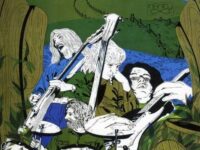Melding rock, blues, and country, Lynyrd Skynyrd revolutionized Southern rock, opening the door for bands like Molly Hatchet, the Marshall Tucker Band, and .38 Special. Today, acts such as the Black Crowes and Kid Rock carry the torch, although no one has replicated the success the genre enjoyed in the early to mid 1970s. Lynyrd Skynyrd managed to integrate the British rock of the Rolling Stones and Cream with swampy Southern blues, topped with Ronnie Van Zant’s genuine delivery and insightful lyrics. While Van Zant and two other band members’ lives were cut tragically short in a 1977 plane crash, their music is still played on radio, and the band’s legacy is assured through their 2006 induction into the Rock and Roll Hall of Fame.
While bar bands may still excite crowds with “Sweet Home Alabama,” few realize just how hard Lynyrd Skynyrd worked to refine their sound and gain fans. The new documentary Gone with the Wind: The Remarkable Rise and Tragic Fall of Lynyrd Skynyrd explores their difficult journey in establishing their identity, distinguishing themselves from the massively popular Allman Brothers Band, and overcoming drug and alcohol addictions. Featuring interviews with friends, associates and former band members including guitarist Ed King and drummer Bob Burns (who died in a car accident before the release of Gone with the Wind), the DVD presents a full, unflinching picture of Lynyrd Skynyrd’s conflicts and controversies as well as their artistic triumphs.
After seeing the Rolling Stones perform in Jacksonville, Fla., in 1965, Ronnie Van Zant became inspired to pursue a career in music. A further influence was Free, best known for their gritty 1970 single “All Right Now.” A fan of lead singer Paul Rodgers, Van Zant modeled his vocals after Rogers’ gravelly delivery. As Ronnie Van Zant and the original band members played local gigs, hoping to be discovered, they purchased a tin-roof shack dubbed “Hell House” in Green Cove Springs, Fla. There, Van Zant relentlessly rehearsed the group; at the same time, he and other Lynyrd Skynyrd members began composing songs. When producer Al Kooper saw the group perform at an Atlanta club in 1972, he signed the band.
Looking for an authentic, organic sound, Lynyrd Skynyrd recorded their debut album at the famed Muscle Shoals Studio. When Pronounced Leh-Nerd Skin-Nerd was released in 1973, it illustrated that the band was not an Allman Brothers clone. “Free Bird,” “Simple Man,” and “Gimme Three Steps” became radio staples, and for good reason: In addition to their tight blues rock, they featured surprisingly introspective lyrics, such as these from “Simple Man”: “Forget your lust for the rich man’s gold / All that you need is in your soul.”
After earning a coveted opening spot for the Who on their Quadrophenia tour (the film points out that the Who was generous with their time and drugs), Lynyrd Skynyrd reentered the studio for what would become their most successful effort, 1974’s Second Helping. At this point, Gone with the Wind: The Remarkable Rise and Tragic Fall of Lynyrd Skynyrd critically examines the band, questioning their choice to drape the Confederate flag on the stage and to seemingly praise Gov. George Wallace, a proponent of segregation, in the hit “Sweet Home Alabama.” Was Lynyrd Skynyrd celebrating such polarizing issues? After all, Ronnie Van Zant wrote the song in response to Neil Young’s scathing criticism of Southern racism in “Southern Man.” The documentary explores this controversy in a nonjudgmental manner, not taking sides but not glossing over some of the more unconformable elements in “Sweet Home Alabama,” either.
Through interviews and rare clips, Gone with the Wind guides viewers through the band’s tragic end. Just after Ronnie Van Zant achieved sobriety and Lynyrd Skynyrd recorded the strong LP Street Survivors (featuring the hits “That Smell” and “What’s Your Name”), Van Zant as well as band members Steve Gaines and Cassie Gaines were killed. The surviving members disbanded, but reunited in 1987. The documentary briefly explores the controversy surrounding the current lineup: Can it really be called “Lynyrd Skynyrd” minus Steve Gaines and Ronnie Van Zant, in particular? Only one original member — Gary Rossington — remains in the reconstituted band.
Casual fans will find Gone with the Wind a thorough, if lengthy, portrait of an iconic 1970s Southern rock band. Hard core enthusiasts may already know Lynyrd Skynyrd’s history, but they will appreciate the rare footage, as well as Bob Burns’ brutally honest assessments of his time in the group. Anyone who wants to learn about how the band transformed Southern rock and how their impact lingers will find Gone with the Wind: The Remarkable Rise and Tragic Fall of Lynyrd Skynyrd a fascinating journey.
- The Rescued Early Paul McCartney Song That Completed ‘Beatles For Sale’ - December 4, 2024
- A Rare Beatles Cover Proves John Lennon Was Wrong About His Voice - November 26, 2024
- How John Lennon Came Roaring Back on the Beatles’ White Album - November 22, 2023




Excellent doc!